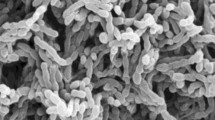Summary
Typecultures are designated for the species Streptomyces thermoviolaceus ssp. thernoviolaceus and ssp. apingens, S. thermovulgaris, Pseudonocardia thermophila and Microbispora bispora; neotypes are proposed for Thermonospora curvata and Streptomyces rectus=Actinomyces thermophilus sensu Gilbert.
Thermonospora curvata is chosen as type species of the genus Thermonospora. The genus Thermopolyspora becomes a synonym of Microbispora. A new genus will have to be erected for Thermopolyspora polyspora, Th. flexuosa and Th. rectivirgula, which do not fit into the genus Microbispora.
The fine structure of the spores of some thermophilic species is described. Streptomyces thermovulgaris, Pseudonocardia thermophila and Microbispora bispora have smooth spore walls; spines are developed in Streptomyces rectus and Thermomonospora curvata, and warts in Streptomyces thermoviolaceus. The warts have been found to possess a median depression.
Ultrathin sections were cut of the spores and hyphae of Thermomonospora curvata. The spine bearing layer forms a loose sheath around the smooth, thick wall of the spore as is reported in Microellobosporia. This may indicate relationship between these two genera.
In Pseudonocardia thermophila the development of the substrate and aerial mycelia and the spore formation has been studied in detail. Both the substrate and aerial hyphae are septate. Four kinds of spores were observed: fragmentation spores in the substrate hyphae, fragmentation spores in the aerial hyphae, segmentation spores in the aerial hyphae produced according to the “Pseudonocardia-type”, and spores formed in the aerial hyphae according to the “Streptomyces-type”.
Among the non-sporangiate actinomycetes five types of aerial spore formation are discussed, the Streptomyces-type, Microbispora-type, Thermomonospora-type, Pseudonocardia-type, and the formation of spores described by Krassilnikov and Agre for two species of Thermopolyspora.
Zusammenfassung
Für Thermomonospora curvata und Streptomyces rectus=Actinomyces thermophilus sensu Gilbert werden Neotypen vorgeschlagen. Für Streptomyces thermoviolaceus ssp. thermoviolaceus und ssp. apingens, S. thermovulgaris, Pseudonocardia thermophila und Microbispora bispora werden Typusstämme ausgewählt.
Thermomonospora curvata wird als Typusart für die Gattung Thermomonospora gewählt. Die Gattung Thermopolyspora wird Synonym von Microbispora. Von den Thermopolyspora-Arten kommt nur Th. bispora zur Gattung Microbispora. Für Th. polyspora, Th. flexuosa und Th. rectivirgula ist später eine neue Gattung aufzustellen.
Folgende Sporenfeinstruktur wurde für die thermophilen Arten festgestellt: Bei Streptomyces thermovulgaris, Pseudonocardia thermophila und Microbispora bispora sind die Spore glatt, sie sind stachelig bei Streptomyces rectus und Thermomonospora curvata und warzig bei Streptomyces thermoviolaceus. Die Warzen sind in der Mitte vertieft.
Ultradünnschnitte wurden von den Sporen von Thermomonospora curvata hergestellt. Die Stacheln werden durch die Falten einer Hülle gebildet, welche locker die dickwandige, glatte Spore umgibt. Die Ähnlichkeit der Bilder mit Microellobosporia ist vielleicht ein Hinweis auf eine mögliche Verwandtschaft der beiden Gattungen.
Bei Pseudonocardia thermophila wurden das Mycelwachstum und die Sporenbildung im einzelnen verfolgt. Sowohl die Substrat- als auch die Lufthyphen sin septiert. Viererlei Sporen werden gebildet: Zerfallssporen im Substratmycel, Zerfallssporen im Luftmycel, Segmentationssporen in den Lufthyphen=Entstehung nach dem Pseudonocardia-Typ und Sporenbildung in den Lufthyphen nach dem Streptomyces-Typ.
Fünf Formen der Luftsporenbildung werden diskutiert: der Streptomyces-Typ, der Microbispora-Typ, der Thermomonospora-Typ, der Pseudonocardia-Typ und die Sporenbildung, wie sie Krassilnikov u. Agre für Thermopolyspora-Arten beschrieben.
Similar content being viewed by others
Literatur
Brenner, S., and R. W. Horne: A negative staining method for high resolution electron microscopy of viruses. Biochim. biophys. Acta (Amst.) 34, 103–110 (1959).
Couch, J. N.: Some new genera and species of the Actinoplanaceae. J. Elisha Mitchell Sci. Soc. 79, 53–70 (1963).
Drechsler, C.: Morphology of the genus Actinomyces. Bot. Gaz. 67, 65–83, 147#x2013;164 (1919).
Emerson, R.: Mycological organization. Mycologia 5, 589–621 (1958).
Flaig, W., H. Beutelspacher, E. Küster u. G. Segler-Holzweissig: Beiträge zur Physiologie und Morphologie der Streptomyceten. Plant and Soil 4, 118–127 (1952).
—, E. Küster u. H. Beutelspacher: Elektronenmikroskopische Untersuchungen an Sporen verschiedener Streptomyceten. Zbl. Bakt., II. Abt. 108, 376–382 (1955).
Frommer, W.: Erfahrungen mit Streptomyceten-Dauerkulturen. Arch. Mikrobiol. 25, 219–222 (1956).
Glauert, A. M., and D. A. Hopwood: The fine structure of Streptomyces violaceoruber (S. coelicolor). III. The walls of the mycelium and spores. J. biophys. biochem. Cytol. 10, 505–516 (1961).
Gordon, R. E., and J. M. Mihm: Sporulation by two strains of Nocardia asteroides. J. Bact. 75, 239–240 (1958).
Hagedorn, H.: Elektronenmikroskopische Untersuchungen an Streptomyces griseus. Zbl. Bakt., II. Abt. 113, 234–253 (1960).
Henssen, A.: Beiträge zur Morphologie und Systematik der thermophilen Actinomyceten. Arch. Mikrobiol. 26, 373–414 (1957).
Krassilnikov, N. A., 1949: Guide to the identification of Bacteria and Actinomycetes. Academy of Sciences, USSR, Moskau, in der Übersetzung von J. B. Routien herausgegeben. U.S.A.: Pfizer & Co. 1957.
—, and N. S. Agre: On two species of Thermopolyspora. Hind. Antibiot. Bull. 6, 97–107 (1964).
Küster, E., and R. Locci: Transfer of Thermoactinomyces viridis Schuurmans et al. 1956 to the genus Thermomonospora as Thermomonospora viridis (Schuurmans, Olson and San Clemente) comb. nov. Int. Bull. bact. Nomencl. 13, 213–216 (1963).
Kutzner, H. J.: Beitrag zur Systematik und Ökologie der Gattung Streptomyces Waksman et Henrici. Dissertation, Landwirtschaftliche Hochschule Stuttgart-Hohenheim 1956.
Lechevalier, H. A.: Priority of the generic name Microbispora over Waksmania and Thermopolyspora. Int. Bull. bact. Nomencl. 15, 139–142 (1965).
Lechevalier, M. P., and H. A. Lechevalier: A new genus of the Actinomycetales: Waksmania gen. nov.. J. gen. Microbiol. 17, 104–111 (1957).
Nonomura, H., and I. Ohara: On a new actinomycete, Microbispora, isolated from soil. Abstrakt 98, präsentiert zum Annual Meeting of the Agricultural Chemical Society of Japan. Universität Tokyo (auf Japanisch) (1957a).
——: Distribution of actinomycetes in soil. II. Microbispora, a new genus of the Streptomycetaceae. J. Ferment Technol. (Japan) 35, 307–311 (1957b).
Rancourt, M., and H. A. Lechevalier: Electron microscopic observation of the sporangial structure of an actinomycete, Microellobosporia flavea. J. gen. Microbiol. 31, 495–498 (1963).
——: Electron microscopic study of the formation of spiny conidia in species of Streptomyces. Canad. J. Microbiol. 10, 311–316 (1964).
Vernon, T. R.: Spore formation in the genus Streptomyces. Nature (Lond.) 176, 935–936 (1955).
Waksman, S.: The Actinomycetes, vol. I. Baltimore: Williams & Wilkins 1959.
—: The Actinomycetes, vol. II. Baltimore: Williams & Wilkins 1961.
Author information
Authors and Affiliations
Rights and permissions
About this article
Cite this article
Henssen, A., Schnepf, E. Zur Kenntnis thermophiler Actinomyceten. Archiv. Mikrobiol. 57, 214–231 (1967). https://doi.org/10.1007/BF00405948
Received:
Issue Date:
DOI: https://doi.org/10.1007/BF00405948




